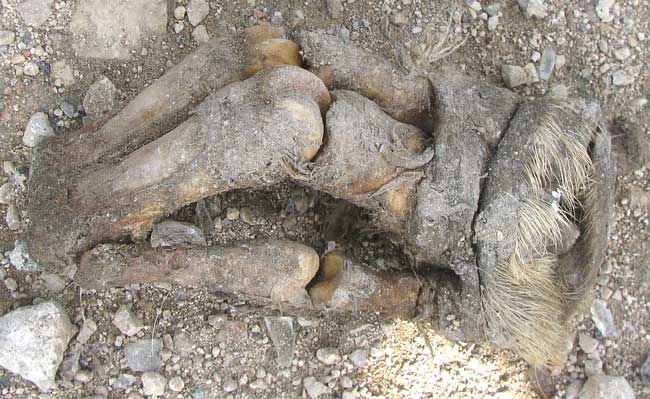Excerpts from Jim Conrad's
Naturalist Newsletter

from the September 19, 2010 Newsletter issued from Hacienda Chichen Resort beside Chichén Itzá Ruins, central Yucatán, MÉXICO; limestone bedrock, elevation ~39m (~128ft), ~N20.676°, ~W88.569°
BONES IN PIGS' FEET
As a very fat kid on the Kentucky farm back in the l950s I always got excited when my mother brought home a jar of pickled pig feet. Anyone seeing how I devoured them then wouldn't have imagined that I'd spend the adult part of my life as a vegetarian. So, I had conflicting feelings last weekend during my bike ride south of Pisté when I entered the municipal garbage dump to snoop around for interesting fugitive plants, and saw that someone had dropped quite a few chopped-off pig feet all along the entrance road.
Black Vultures clustered around every severed foot pecking, stabbing and tugging. Most feet by now consisted of nothing but bones and a little hairy hide and flakes of brittle hoof. It was the bones that got my attention. I remembered how during horse evolution each foot lost four toes, so that now nothing remains inside a horse's hoof except a much enlarged middle toe. Horses and their relatives run on the tips of their feet's single toe bones -- a condition zoologists refer to as having "mesaxonic" feet.
But the grizzly remains of pig feet on the road that day clearly showed more than one big toe inside each hoof. If you can bear to look at the vulture-pecked remains of a pig foot, you can see what I saw at the top of this page. It almost looks like the remains of a human hand daintily closing its fingertips around something small.
It turns out that the evolution of the feet of pigs and horses took very different paths. Instead of pigs having mesaxonic feet, they have paraxonic ones. That means that instead of losing all but the middle digit, which then became much larger, pig feet lost their "big toe" completely, but kept the remaining four, and of those four the two middle toes developed to be much larger than the two side toes. Besides pigs, deer, bison and elk have paraxonic feet.
So, in the picture, the two top sets of bones are the large toes while the lower one is one of the small toes, the other small toe being hidden, or maybe vulturized.
I ate my last pickled pig's foot many years ago, but it seems as if I don't remember having bones left after finishing off a jar of them. (After eating my first artichoke I didn't have anything left over, either... ) Trying to remember whether I ate the bones, which must have been soft and crumbly, I asked my Maya friend who goes by the name of Cancún if people around here eat pig's feet, and, if they do, whether the bones are soft.
He replied that if the pigs are cochinas americanas, meaning pigs raised in pens and fed special food so that they grow fast and are killed after only about six months, the foot bones are fairly soft. However, if they are cochinas Mayas, who roam around and eat squash, roots and what's left over from people's meals, they're killed only after several years, and then their foot bones are hard.
That's interesting, but I'm still left wondering whether back in the 1950s after eating a jar of pickled pig's feet I had any bones left over, or at least should have had.